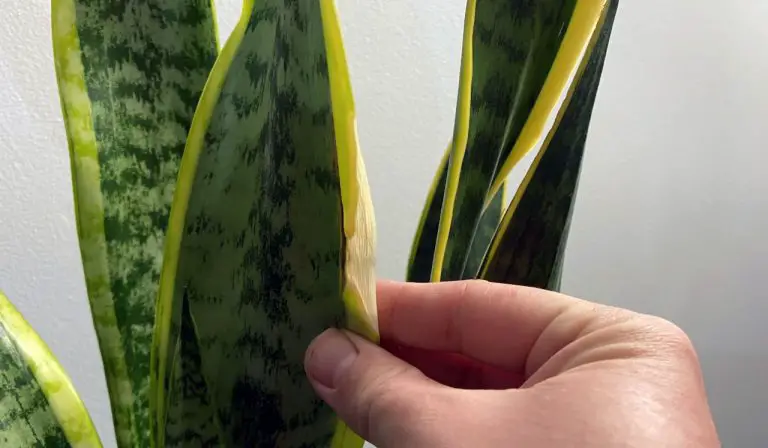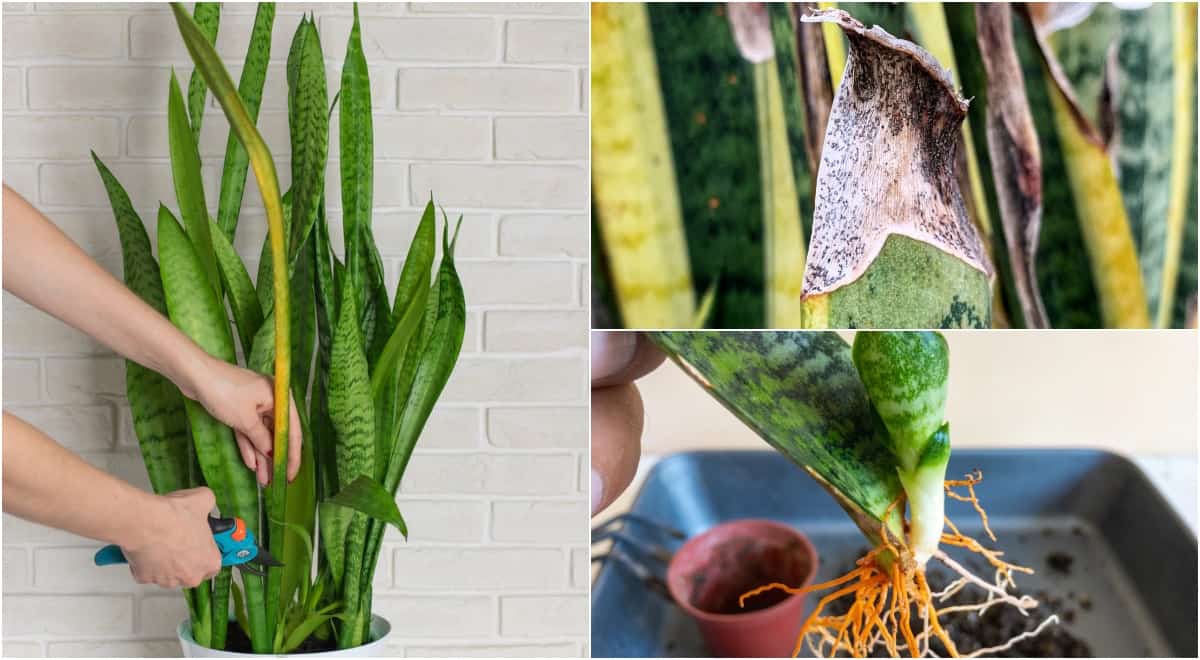
Blemished Beauty: Tackling Snake Plant Brown Spots
Brown spots on snake plants indicate a watering issue or pest infestation. Snake plants are commonly grown as houseplants and are known for their easy-care nature, making them a popular choice for beginners or those who don’t have much time to devote to plant care.
While snake plants are generally hardy, they can still develop issues from time to time, such as brown spots. In this article, we’ll explore the various causes of brown spots on snake plants and provide tips on how to treat and prevent them from occurring.

Credit: www.bloomingbackyard.com
What Causes Brown Spots On Snake Plants?
Explanation Of The Causes Of Brown Spots On Snake Plants
Snake plants are easy-going and low-maintenance houseplants, but brown spots on the leaves can indicate a problem. Here are the main causes of brown spots on snake plants:
Overwatering
Overwatering can damage the snake plant’s roots, causing brown spots on the leaves. When the soil is too wet, it doesn’t allow oxygen to reach the roots, which can lead to root rot, a fungal disease that causes brown spots.
Signs of overwatering include:
- Yellowing leaves
- Soft, soggy leaves
- Musty smelling soil
- Brown, mushy roots
To fix overwatering, let the soil dry between watering and remove any dead or mushy roots with sterilized scissors.
Underwatering
Not watering the snake plant enough can cause brown spots on the leaves. When the soil is dry, the plant can’t get the moisture it needs to thrive, and its leaves may start to brown at the tips or along the edges.
Signs of underwatering include:
- Crispy, dry leaves
- Wilting
- Brown, crispy leaf tips
- Dull, lifeless leaves
To fix underwatering, give your snake plant a good drink of water and make sure it’s in a well-draining pot.
Inadequate Light
Lack of adequate light exposure can also cause brown spots on the snake plant. These plants require indirect bright light, and when they are placed in a low-light environment, the leaves can turn yellow and then brown.
Signs of inadequate light include:
- Yellow leaves
- Weak, thin leaves
- Limpness
- Stunted growth
To fix inadequate lighting, move your snake plant to a brighter spot, but not in direct sunlight.
Pest Infestation
Pests can also cause brown spots on snake plant leaves. Mealybugs and spider mites can cause brown spots by piercing the plant’s cell walls and draining the plant’s moisture. As a result, the leaves may appear discolored and covered in a sticky substance that causes brown spots.
Signs of pest infestation include:
- Brown spots with webbing
- Yellowing leaves
- Sticky residue on foliage
- Distorted foliage
To fix pest infestations, use an insecticidal soap to remove the pests and their sticky residue.
Now that you know what causes brown spots on snake plants, you can take the appropriate actions to restore your plant’s health!
Blemished Beauty: Tackling Brown Spots On Snake Plant
Despite being often considered low-maintenance indoor plants, snake plants can sometimes develop brown spots that can affect their overall beauty. These brown spots can be caused by a number of different factors, including over or under-watering, poor lighting, and pest infestations.
Importance Of Tackling Brown Spots On Snake Plants
Tackling brown spots on your snake plant is crucial for maintaining its appearance and ensuring that it stays healthy. Brown spots can be an indication of an underlying issue that needs to be addressed to prevent further damage to the plant. Inspecting the plant closely for signs of pests, disease, or overwatering is essential in determining the cause of the brown spots on leaves. Once the root cause is identified, appropriate measures such as adjusting the watering schedule, repotting the plant, or using organic insecticides can be taken to address the issue and promote the plant’s recovery. Regular monitoring and proper care will help prevent brown spots on leaves from recurring and keep your snake plant thriving.
Natural Ways To Revive And Restore The Beauty Of Snake Plants
The good news is that there are several natural ways you can revive and restore the beauty of your snake plant. These methods include:
- Adjusting watering frequency: Over or under-watering can cause brown spots to appear on your snake plant. Make sure you are watering your plant properly and adjust the frequency if necessary.
- Providing adequate lighting: Snake plants thrive in bright, indirect light. If your plant is not getting enough light, move it closer to a window or place it under a grow light.
- Pest management techniques: Spider mites, mealybugs, and other pests can cause brown spots on snake plants. Use natural pest management techniques like neem oil or insecticidal soap to control the infestation.
Chemical Options For Treating Brown Spots On Snake Plants
If natural methods do not work, there are several chemical options you can use to treat brown spots on your snake plant. These include:
- Types of fertilizers: Use a balanced fertilizer to provide your snake plant with the nutrients it needs to grow healthy leaves. Make sure to follow the instructions on the fertilizer package for best results.
- Insecticides and fungicides: If your snake plant has a severe pest or fungal infection, you may need to use a chemical insecticide or fungicide to treat the problem. Make sure to choose a product that is safe for indoor use and follow the instructions carefully.
- Proper application techniques: No matter which chemical option you choose, make sure to apply it carefully and according to the instructions on the product label. Using too much or applying it incorrectly can damage your snake plant.
Tackling brown spots on your snake plant takes time and effort, but with the right techniques, you can bring your plant back to its former beauty. By adjusting watering frequency, providing adequate lighting, and using natural or chemical methods as needed, you can enjoy a healthy and beautiful snake plant for years to come. If you notice brown spots on your snake plant, first assess the watering schedule and make sure the soil is not too soggy. Consider moving the plant to a spot with more indirect sunlight as well as providing a balanced fertilizer every few months. If you’re unsure about caring for your snake plant or any other houseplant, consider doing some research on reliable resources to learn how to grow onions from seed and care for various plants. With patience and proper care, your snake plant will thrive once again.
Tips To Prevent Brown Spots On Snake Plants
Essential Tips To Prevent The Occurrence Of Brown Spots On Snake Plants
Snake plants, also known as sansevierias, are tough and straightforward to care for, making them popular indoor plants. However, they are prone to getting brown spots, which can make them look unsightly. Here are some essential tips to prevent the occurrence of brown spots on snake plants.
Proper Watering Techniques
Over or under-watering is the most common cause of brown spots on snake plants. Here are some proper watering techniques to keep the soil moist and your snake plant hydrated:
- Water your snake plant only when the top 2-3 inches of soil are dry.
- Water your plants with room temperature tap water and avoid using hard water or distilled water.
- Make sure your container has drainage holes to prevent stagnant water.
Ideal Lighting Requirements
The ideal lighting requirements for snake plants are mostly moderate to low light conditions. Here are some tips for ideal lighting requirements that prevent brown spots:
- Keep your snake plant in a well-lit room but away from direct sunlight.
- Cool fluorescent bulbs can improve the growth of snake plants, especially during the winter months.
- Rotate your plant regularly to ensure that all the leaves receive equal amounts of light.
Soil Type And Nutrition
Soil type and the right nutrition are essential for healthy snake plants. Here are some tips for the right soil type and nutrition:
- Use well-draining soil with peat moss, coarse sand, and perlite to create an ideal soil mix.
- Fertilize your snake plant with a balanced, water-soluble fertilizer every three to four months during the growing season.
- Apply fertilizer to the snake plant’s soil only when the topsoil is moist to avoid burning the roots.
Regular Cleaning
Dust and dirt can accumulate on snake plant leaves, causing brown spots to appear. Here are some tips for regular cleaning:
- Wipe the leaves gently with a damp cloth and remove any dust or dirt buildup.
- Use a leaf shine spray, specifically formulated for snake plants, to give the leaves a nice shine and remove any residue.
These essential tips will help you prevent brown spots on your snake plants and keep them healthy and thriving. Remember to follow these tips strictly and enjoy your beautiful indoor plants!
Frequently Asked Questions For Brown Spots On Snake Plant
What Causes Brown Spots On Snake Plant Leaves?
Brown spots on snake plant leaves are usually caused by overwatering, pests such as spider mites or mealybugs, or exposure to cold temperatures. It’s important to identify the root cause before attempting to treat the plant.
How Do You Treat Brown Spots On A Snake Plant?
Treatment for brown spots on a snake plant varies depending on the cause. If caused by overwatering, allow the plant to fully dry out before watering again. Pest infestations can be treated with insecticidal soap or neem oil. Trim off any severely damaged leaves.
Can Brown Spots On A Snake Plant Be A Sign Of Disease?
Brown spots on a snake plant can be a sign of disease, particularly fungal or bacterial diseases. However, it’s more commonly caused by environmental factors such as overwatering or pests. Proper diagnosis is key to effective treatment.
How Do You Prevent Brown Spots On A Snake Plant?
To prevent brown spots on a snake plant, ensure it is in the proper environment with adequate lighting and temperature. Water the plant only when the soil feels dry to the touch. Regularly inspect the leaves for any signs of pests or disease.
Can Brown Spots On A Snake Plant Be Harmful To Humans Or Pets?
Brown spots on a snake plant are typically not harmful to humans or pets. However, if the cause is a toxic chemical or harmful pesticide, there could be potential risks. It’s best to identify the cause of the brown spots and take appropriate action.
Can Snake Plants Recover From Brown Spots?
Snake plants can recover from brown spots with proper treatment and care. Remove any severely damaged leaves, identify and address the root cause, and provide the proper environment for growth. With the right care, the plant can make a full recovery and start producing healthy leaves again.
Conclusion
After delving into the possible causes of brown spots on snake plants, we can safely conclude that these issues should not be taken lightly. It is important to diagnose the problem early on and take appropriate measures to treat and prevent further damage to the plant.
Whether it’s due to excessive sunlight, overwatering, or insect infestation, the good news is that most of these issues can be easily resolved by making some simple adjustments to your care routine. Regular inspections, proper drainage, and a well-balanced watering schedule can go a long way in keeping your snake plant healthy and thriving.
Remember to always keep an eye out for early signs of problems, so you can take prompt action and prevent the issue from getting worse. With a little love and care, your snake plant will reward you with lush green leaves and vibrant beauty for years to come.
Related Articles:
10 Best Small Evergreen Trees with Non Invasive Roots
 Dr Ahsanur Rahman, PHD
Dr Ahsanur Rahman, PHDPine Tree Rescue: Saving Pine Trees with Brown Needles
 Dr Ahsanur Rahman, PHD
Dr Ahsanur Rahman, PHD





